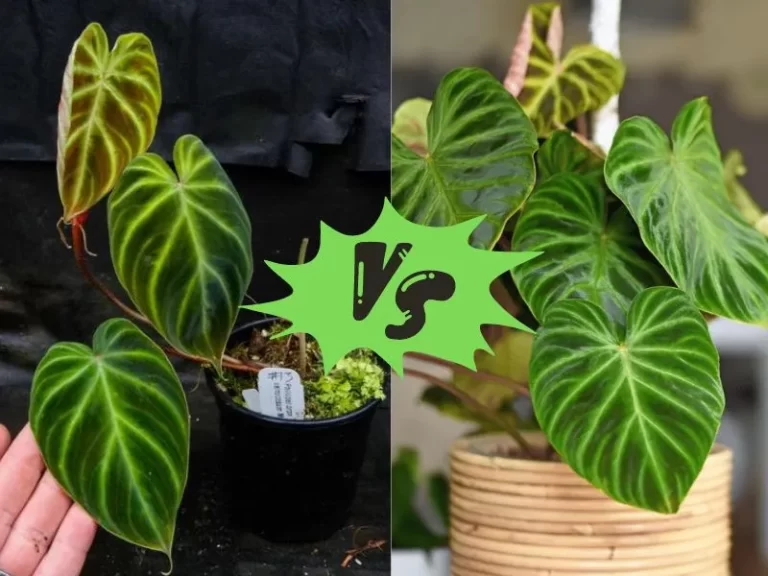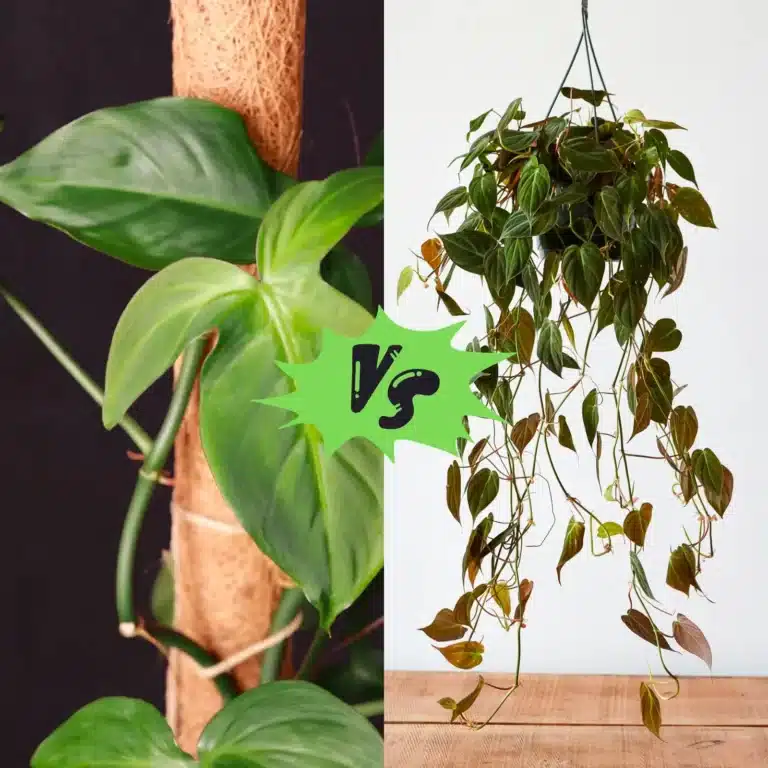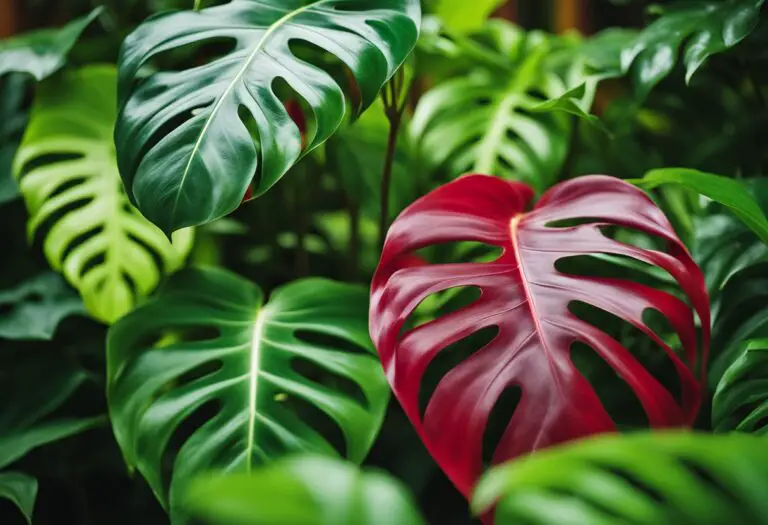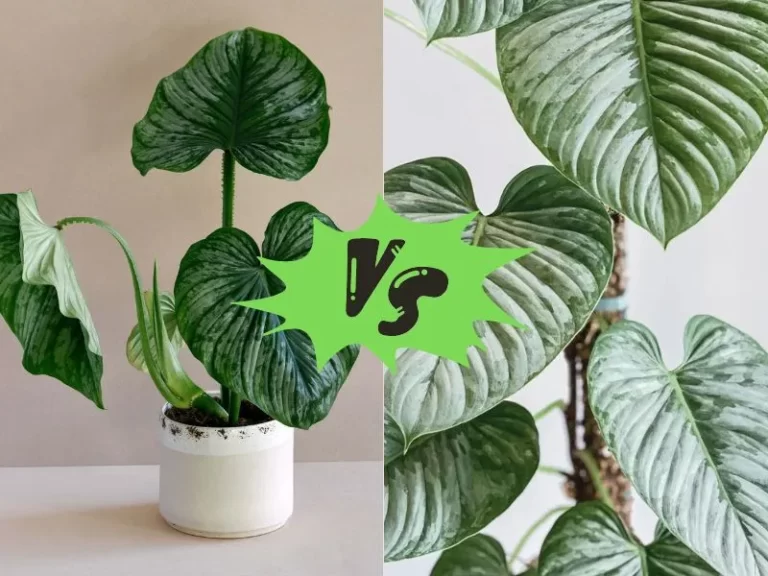Philodendron Sodiroi vs Brandtianum: A Friendly Comparison
If you’re a plant lover, always on the lookout for new additions, this article is for you. We’ll explore two captivating philodendron varieties: Philodendron sodiroi and Philodendron brandtianum, helping you choose the right one for your garden.
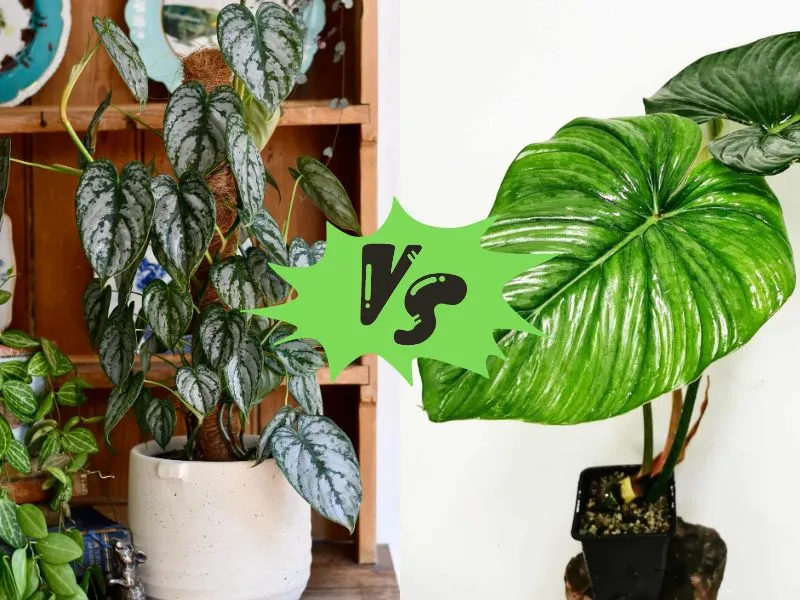
Understanding their characteristics is essential. Philodendron sodiroi boasts impressive ribbed, heart-shaped leaves and is a climber, while Philodendron brandtianum is well-suited to low or indirect light.
Now, let’s delve deeper into their unique features and differences.
Key Takeaways
- Philodendron sodiroi and Philodendron brandtianum are two captivating varieties of philodendron that are worth exploring.
- Understanding the characteristics of each plant is essential to making an informed decision.
- The Philodendron sodiroi is an impressive plant known for its big, stunning ribbed, heart-shaped leaves, while Philodendron brandtianum is a trailing or climbing type of philodendron that is naturally well-suited to low light conditions or bright indirect light.
Philodendron Sodiroi vs Brandtianum
If you’re looking for a new addition to your plant collection, you might want to consider the Philodendron Sodiroi or the Philodendron Brandtianum. Both of these plants are captivating and will add a lush green touch to your home.
But how do you choose between them? Here’s a comparison of the two plants to help you decide.
Appearance
The Philodendron Sodiroi and the Philodendron Brandtianum are both beautiful plants, but they have some noticeable differences in appearance. The Philodendron Sodiroi has large, heart-shaped leaves that are a deep green color.
The leaves have prominent veins and a glossy texture. On the other hand, the Philodendron Brandtianum has smaller, more delicate leaves that are a lighter green color. The leaves of the Philodendron Brandtianum are also variegated with silver markings.
| Feature | Philodendron Sodiroi | Philodendron Brandtianum |
|---|---|---|
| Leaf size | Large | Small |
| Leaf color | Deep green | Light green with silver markings |
| Leaf texture | Glossy | Delicate |
Care
When it comes to care, the Philodendron Sodiroi and the Philodendron Brandtianum have similar requirements. Both plants prefer bright, indirect light and well-draining soil. They also both enjoy high humidity levels, so it’s a good idea to mist them regularly.
However, there are some differences in care that you should be aware of. The Philodendron Sodiroi grows best in temperatures between 65-80°F, while the Philodendron Brandtianum prefers slightly cooler temperatures between 60-75°F.
Additionally, the Philodendron Sodiroi can grow quite large and will need to be repotted every 1-2 years, while the Philodendron Brandtianum stays smaller and can go longer between repottings.
Price
The price of the Philodendron Sodiroi and the Philodendron Brandtianum can vary depending on where you buy them. However, in general, the Philodendron Sodiroi tends to be more expensive than the Philodendron Brandtianum. This is likely due to the larger size of the Philodendron Sodiroi and its reputation as a rare and sought-after plant.
Overall, both the Philodendron Sodiroi and the Philodendron Brandtianum are beautiful plants that will make a great addition to your home. Consider your personal preferences in terms of appearance and care requirements when deciding between the two.
Understanding Philodendron Sodiroi
If you’re a houseplant enthusiast, you’ve probably heard of Philodendron Sodiroi. This plant is known for its big, stunning ribbed, heart-shaped leaves.
It’s one of the most sought-after plants in the Philodendron family and is often confused with Philodendron Brandtianum. In this section, we’ll go over everything you need to know about Philodendron Sodiroi.
Origin and History
Philodendron Sodiroi is native to Ecuador and was named after Ecuadorian botanist, Emilio Sodiro. The plant grows in the wild in the Andes Mountains, where it can reach heights of up to 3 meters. It was first introduced to the United States in the late 1800s and has since become a popular houseplant.
Growth and Care
Philodendron Sodiroi is a relatively easy plant to care for. It prefers bright, indirect light and well-draining soil. The plant can tolerate lower light conditions, but it may not grow as quickly or produce as many leaves.
It’s important to keep the soil moist but not waterlogged, as overwatering can lead to root rot.
Here are a few more tips for growing and caring for Philodendron Sodiroi:
- Temperature: The plant can tolerate a wide range of temperatures, but it prefers temperatures between 60-75°F.
- Humidity: Philodendron Sodiroi prefers high humidity, but it can tolerate lower humidity levels.
- Fertilizer: Use a balanced fertilizer every 4-6 weeks during the growing season.
- Repotting: Repot the plant every 1-2 years, or when it outgrows its current container.
Common Issues
Like any plant, Philodendron Sodiroi can experience issues. Here are a few common problems you may encounter:
- Pest infestations: The most common pests that affect Philodendron Sodiroi are spider mites and mealybugs. Inspect your plant regularly and treat any infestations promptly.
- Brown leaf tips: Brown leaf tips can be a sign of underwatering or low humidity. Make sure you’re watering your plant regularly and consider using a humidifier.
- Yellow leaves: Yellow leaves can be a sign of overwatering or nutrient deficiencies. Make sure you’re not overwatering your plant and consider fertilizing it more frequently.
Overall, Philodendron Sodiroi is a stunning plant that can add a touch of tropical beauty to any home. With the right care, it can thrive and produce beautiful, ribbed leaves that are sure to impress.
Delving into Philodendron Brandtianum

If you’re looking for a beautiful and exotic indoor plant, the Philodendron Brandtianum might just be what you’re looking for.
This plant, also known as the silver leaf philodendron, is a variegated plant with heart-shaped olive green leaves that are splashed with silver markings. In this section, we will delve into the origin and history, growth and care, and common issues of the Philodendron Brandtianum.
Origin and History
The Philodendron Brandtianum is native to South America, specifically Brazil, Ecuador, and Peru. It belongs to the Araceae family and is part of the Philodendron genus. The plant was first discovered in the 19th century and has since become a popular houseplant due to its unique foliage.
Growth and Care
The Philodendron Brandtianum is a relatively easy plant to care for, making it a great choice for beginners. Here are some tips on how to care for this plant:
- Light: The Philodendron Brandtianum grows best with bright, indirect light. Avoid placing it in direct sunlight as it can burn the leaves.
- Watering: Water your plant when the top inch of soil is dry. Be careful not to overwater as this can cause root rot.
- Humidity: The Philodendron Brandtianum prefers high humidity levels. You can increase humidity by misting the leaves or placing a humidifier nearby.
- Soil: Use well-draining soil that is rich in organic matter.
- Fertilizer: Feed your plant with a balanced fertilizer every 2-3 months during the growing season.
- Repotting: Repot your plant every 1-2 years or when the roots become crowded.
Common Issues
Like any plant, the Philodendron Brandtianum can suffer from a few common issues. Here are some of the most common problems and how to fix them:
- Yellow leaves: Yellow leaves can be a sign of overwatering or underwatering. Make sure you are watering your plant properly and adjust as necessary.
- Brown tips: Brown tips can be caused by low humidity levels. Increase humidity by misting the leaves or placing a humidifier nearby.
- Pests: The Philodendron Brandtianum can be susceptible to spider mites, mealybugs, and scale insects. Keep an eye out for any signs of infestation and treat with insecticidal soap or neem oil.
Overall, the Philodendron Brandtianum is a beautiful and easy-to-care-for plant that can add a touch of exotic beauty to any home. With proper care, you can enjoy this plant for years to come.
Key Differences between Philodendron Sodiroi and Brandtianum
If you’re a plant enthusiast, then you might have heard about Philodendron Sodiroi and Brandtianum. Both of these plants are beautiful and feature captivating foliage. However, they have some key differences that set them apart.
Appearance
One of the most obvious differences between Philodendron Sodiroi and Brandtianum is their appearance. Philodendron Sodiroi has large, heart-shaped leaves with prominent ribbing, while Brandtianum has smaller, more elongated leaves with a distinct pattern of silver veins.
Growth Habit
Another difference between these two plants is their growth habit. Philodendron Sodiroi is a climber, while Brandtianum is a trailing plant.
This means that Philodendron Sodiroi needs some support to grow upwards, while Brandtianum can trail down from a hanging basket or climb a trellis.
Light Requirements
Both Philodendron Sodiroi and Brandtianum thrive in bright, indirect light. However, Philodendron Sodiroi can tolerate more direct sunlight than Brandtianum.
If you’re growing Philodendron Sodiroi, you can place it in a spot that gets a few hours of direct sunlight each day, while Brandtianum should be kept away from direct sunlight.
Care Requirements
In terms of care requirements, Philodendron Sodiroi and Brandtianum are relatively easy to care for. Both plants prefer well-draining soil that is kept evenly moist, but not waterlogged. You can fertilize both plants every few months with a balanced fertilizer to promote healthy growth.
Choosing the Right Philodendron for Your Garden
Are you considering adding a philodendron to your indoor or outdoor garden? With so many different varieties to choose from, it can be challenging to select the right one for you.
In this section, we’ll take a closer look at the differences between Philodendron Sodiroi and Brandtianum to help you make an informed decision.
Philodendron Sodiroi
The Philodendron Sodiroi is an impressive plant with big, stunning ribbed, heart-shaped leaves. It is a climber, not a crawler like the gloriosum, and is normally bigger than the gloriosum. The plant requires well-draining, nutrient-rich soil, which should also be considered when fertilizing.
When it comes to lighting, the Philodendron Sodiroi prefers bright, indirect light. Avoid direct sunlight as it can burn the leaves. The plant can handle a range of temperatures, but it prefers warm temperatures between 65°F and 80°F (18°C to 27°C).
Philodendron Brandtianum
The Philodendron Brandtianum is another popular houseplant that is often confused with the Sodiroi. The Brandtianum has smaller leaves that are more elongated and pointed. The plant prefers bright, indirect light and well-draining soil. It is also important to avoid overwatering the plant as it can lead to root rot.
When it comes to temperature, the Philodendron Brandtianum prefers warm temperatures between 65°F and 85°F (18°C to 29°C). The plant can tolerate a range of humidity levels, but it prefers higher humidity levels.
Which One is Right for You?
When choosing between the Philodendron Sodiroi and Brandtianum, it ultimately comes down to personal preference. If you are looking for a larger, more impressive plant with big, stunning ribbed, heart-shaped leaves, then the Sodiroi may be the right choice for you. However, if you prefer a smaller plant with elongated and pointed leaves, then the Brandtianum may be a better fit.
It is also important to consider the growing conditions in your home or garden. If you have bright, indirect light and warm temperatures, then both plants should thrive. However, if you have lower light levels or cooler temperatures, then the Brandtianum may be a better choice as it is more tolerant of these conditions.
Frequently Asked Questions
What are the distinguishing features of Philodendron sodiroi and brandtianum?
Philodendron sodiroi is known for its large, ribbed, heart-shaped leaves, while Philodendron brandtianum has medium to large heart-shaped leaves with heavy white to silver markings. Sodiroi is a climber, while Brandtianum is a vine.
What is the care required for Philodendron sodiroi and brandtianum?
Both plants prefer bright, indirect light and well-draining soil. They should be watered when the top inch of soil is dry and fertilized monthly during the growing season. Sodiroi needs more humidity than Brandtianum, and both plants benefit from occasional misting.
Can Philodendron sodiroi and brandtianum be grown together?
Yes, they can be grown together as they have similar care requirements. However, it is important to note that Sodiroi is a climber and may require additional support.
What are the common names for Philodendron sodiroi and brandtianum?
Philodendron sodiroi is also known as Sodiroi Ornatum Silver, while Philodendron brandtianum is sometimes referred to as Silver Leaf Philodendron or Philodendron brandi.
What is the difference between Philodendron sodiroi and Plowmanii?
Philodendron sodiroi has larger leaves with prominent ribs, while Plowmanii has smaller leaves with less pronounced ribbing. Sodiroi is also a climber, while Plowmanii is a trailing plant.
What is the mature size of Philodendron brandtianum?
Philodendron brandtianum can grow up to 3-4 feet in height and 2-3 feet in width.
Conclusion
In conclusion, both Philodendron sodiroi and Philodendron brandtianum are excellent choices for plant lovers looking to add some greenery to their homes. Both plants have unique characteristics that make them stand out from each other.
If you’re looking for a plant with large, stunning ribbed, heart-shaped leaves, then the Philodendron sodiroi is the way to go. This impressive beast of a plant is known for its big, beautiful leaves that will add a tropical feel to any room. However, keep in mind that this plant can grow quite large, so make sure you have enough space for it.
On the other hand, if you’re looking for a plant with unique silver and olive green leaves that change color as they mature, then the Philodendron brandtianum is the perfect choice for you. This trailing plant can reach heights of between four and five feet tall, making it a great option for those looking for a plant that can add some height to a room.
When it comes to care, both plants are relatively easy to care for and can thrive in similar conditions. They both prefer bright, indirect light and well-draining soil. However, it’s important to note that the Philodendron sodiroi can be more sensitive to overwatering than the Philodendron brandtianum, so make sure to let the soil dry out a bit between waterings.
In summary, both the Philodendron sodiroi and Philodendron brandtianum are great options for plant lovers looking to add some greenery to their homes. No matter which one you choose, you’re sure to enjoy their unique characteristics and beauty.

